An investment is a long-term investment in something in order to obtain an effect. This effect can be social and economic. The economic effect of the investment is called profit.
Interest rates that are necessary for calculating the feasibility of investments
In financial mathematics, there are three types of interest rates that an investor applies in calculating the feasibility of his investments. The first rate is the internal rate of return of the investment project (GNI). This index shows what percentage should be taken when calculating the effectiveness of investments.
The second interest rate is the calculation interest itself. This is the rate that the investor lays in his calculation.

The third indicator is called "internal percentage." It shows how much the investment has paid off in percentage terms.
The difference between the GNI of the investment project, internal and calculation interest
All of the above indicators may be equal, but may differ. If you calculate the internal rate of return of the investment project, you can see that these three interest rates do not always have the same value.
The thing is that with a calculation interest, the investor can receive both profit and loss in general and in comparison with an alternative way of using funds. The internal rate of return of an investment project shows the percentage at which the investor receives neither loss nor profit. If the net cost is above zero, this means that the percentage inherent in calculating the effectiveness of investments is below the payback ratio. In the case when the net cost is below zero, the calculation percentage exceeds the GNI of the investment project.

In these cases, it is necessary to calculate the internal percentage, which shows how profitable the investment is.
The concept of rate of return and method of determining it
The key indicator for determining how effective an investment is is the internal rate of return of the investment project. This means that the amount of income received from the implementation of investment activities should be equal to the size of investments. In this case, the flow of payments will be zero.
There are two ways to determine the payback ratio. The first of them is to calculate the internal rate of return of the investment project, provided that the net cost is 0. However, there are times when this indicator is above or below zero. In this situation, it is necessary to “play” with the calculation percentage, increasing or decreasing its value.

It is necessary to find two calculation rates at which the net present value indicator will have minimally negative and minimally positive values. In this case, the payback ratio can be found as the arithmetic average of two calculated interest rates.
The role of current value in calculating the rate of return
Fair value plays a key role in determining the internal rate of return of an investment project. Based on the formula for its determination, the calculation of the internal rate of return of the investment project is also carried out.
Using the fair value method, it is known that the fair value is zero, which means that the invested capital is returned with an increase at the level of calculation interest. In determining the internal interest, such an interest rate is determined at which the current value of a number of payments will be equal to zero.This means at the same time that the current value of the receipts coincides with the current value of the payments.

When using an alternative calculation percentage, one is determined that leads to a fair value of zero.
Calculation of net present value
As already known, the internal rate of return of an investment project is calculated using the net present value formula, which has the following form:
TTS = CFt / (1 + GNI)twhere
- CF - (payment stream the difference between income and expenses);
- GNI - internal rate of return;
- t is the period number.
Payback calculation
The formula for the internal rate of return of an investment project is derived from the formula that is used in the process of determining net present value and has the following form:
0 = CF / (1 + p)1 ... + ... CF / (1 + GNI)n where
- CF - difference between receipts and payments;
- GNI - internal rate of return;
- n is the number of the investment project period.

Manual billing issues
If the investment project is designed for a period of more than three years, the problem of calculating the internal rate of return by means of a simple calculator arises, since equations of the fourth degree arise to calculate the coefficient of a four-year project.
There are two ways to get out of this situation. Firstly, you can use a financial calculator. The second way to solve the problem is much simpler. It consists in using the Excel program.

The program has a function for calculating the rate of return, which is called the IRR. To determine the internal rate of return on investment projects in Excel, you need to select the function SD and in the field "Value" put a range of cells with cash flow.
Graphical Calculation Method
Investors calculated the internal rate of return long before the first computers appeared. To do this, they used the graphical method.
In order to calculate the ratio, you must first determine the net present value for two projects, using two different interest rates.
On the ordinate axis, the difference between the income and expenses of the project should be displayed, and on the abscissa axis, the calculation percentage of the investment project. The type of graphs may be different depending on how the cash flow changes during the investment project. Ultimately, any project will cease to be profitable, and its schedule will cross the abscissa axis, on which the calculation percentage is displayed. The point at which the project schedule crosses the abscissa axis, and there is an internal rate of return on investment.
Example of calculating the internal rate of return
You can analyze the method of determining the payback ratio of a deposit using the example of a bank deposit. Let's say its size is 6 million rubles. The term of the deposit will be three years.
The capitalization rate is 10 percent, and without capitalization - 9 percent. Since the earned money will be withdrawn once a year, the rate without capitalization is applied, that is, 9 percent.
Thus, the payment is 6 million rubles, income - 6 million * 9% = 540 thousand rubles for the first two years. At the end of the third period, the amount of payments will be 6 million 540 thousand rubles. In this case, the GNI will be 9 percent.
If you use 9% as a calculation percentage, the net present value will be 0.
What affects the size of the payback rate?
The internal rate of return of an investment project depends on the size of payments and receipts, as well as on the duration of the project itself. Net present value and payback ratios are interrelated. The higher the ratio, the lower the value of the NTS, and vice versa.

However, there may be a situation where the relationship between the TTS and the internal rate of return is difficult to track. This happens when analyzing several alternative financing options.For example, the first project may be more profitable with one rate of return, at the same time, the second project is able to generate more income with a different rate of return.
Internal percentage
When calculating manually, it is accepted that the internal percentage is determined by interpolating nearby positive and negative current values. At the same time, it is desirable that the used calculation percentages differ no more than 5%.
Example. What is the internal percentage of a number of payments?
Decision:
- We determine the calculation interest, which lead to a negative and positive present value. The closer the current value is to zero, the more accurate the result.
- We determine the percentage using an approximate formula (linear interpolation).
The formula for calculating internal interest is as follows:
Vp = Kpm + Rkp * (ChTSm / Rchts)where
Bp is the internal percentage;
- Kpm - lower calculation percentage;
- Rkp - the difference between lower and higher calculation percent;
- ЧТСм - net present value with a lower calculation percentage;
- Rhts - the absolute difference in current values.
| Year | Payment stream | Cost Percentage = 14% | Cost Percentage = 13% | ||
| Discount coefficient | Discounted payment flow | Discount coefficient | Discounted payment flow | ||
| 1 | -2130036 | 0,877193 | -1868453 | 0,884956 | -1884988 |
| 2 | -959388 | 0,769468 | -738218 | 0,783147 | -751342 |
| 3 | -532115 | 0,674972 | -359162 | 0,69305 | -368782 |
| 4 | -23837 | 0,59208 | -14113 | 0,613319 | -14620 |
| 5 | 314384 | 0,519369 | 163281 | 0,54276 | 170635 |
| 6 | 512509 | 0,455587 | 233492 | 0,480319 | 246168 |
| 7 | 725060 | 0,399637 | 289761 | 0,425061 | 308194 |
| 8 | 835506 | 0,350559 | 292864 | 0,37616 | 314284 |
| 9 | 872427 | 0,307508 | 268278 | 0,332885 | 290418 |
| 10 | 873655 | 0,269744 | 235663 | 0,294588 | 257369 |
| 11 | 841162 | 0,236617 | 199034 | 0,260698 | 219289 |
| 12-25 | 864625 | 1,420194 | 1227936 | 1,643044 | 1420617 |
| Current value | -69607 | 207242 | |||
According to the table, you can calculate the value of the internal percentage. The discounted payment flow is calculated by multiplying the discount factor by the size of the payment flow. The amount of discounted payment flows is equal to the net present value. The internal percentage in this example is:
13 + 1 * (207 242 / (207 242 + 69 607)) = 13,75%
Interpretation of internal interest
A certain internal percentage can be interpreted:
- If the internal percentage is greater than the specified calculation percentage p, then the investment is evaluated positively.
- If the internal and calculation percentages are equal, it means that the invested capital is returned with the necessary increase, however, this does not create additional profit.
- If the internal interest is lower than p, then there is a loss of interest, because the invested capital in alternative use would receive more growth.
- If the internal percentage is below 0, then there is a loss of capital, i.e. invested capital on investment income is only partially returned. The increase of interest on capital does not occur.

The advantage of domestic interest is the fact that it does not depend on the volume of investment and is therefore suitable for comparing investments with different investment volumes. This is a very big advantage over the fair value method.